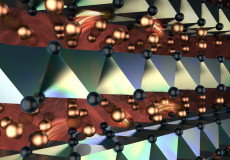Simulations Run at NERSC Confirm Thermal and Electrical Properties of Superionic Crystals
New atomic insights could lead to safer, more efficient rechargeable batteries
October 9, 2018
Contact: Kathy Kincade, kkincade@lbl.gov, +1 510 495 2124
This feature is adapted from a Duke University press release.

An artistic rendition of the intriguing superionic crystalline structure of CuCrSe2, which has copper ions that move like liquid between solid layers of chromium and selenium, giving rise to useful electrical properties. Image: Jill Hemman, Oak Ridge National Laboratory
Using a combination of experiments and simulations, materials scientists have sussed out the physical phenomenon underlying the promising electrical and thermal properties of a class of materials called superionic crystals. A better understanding of such materials could lead to safer and more efficient rechargeable batteries than the current standard-bearer of lithium ion.
Becoming a popular topic of study within the past five years, superionic crystals are a cross between a liquid and a solid. While some of their atoms retain a rigid crystalline structure akin to a frozen state, others become liquid-like above a certain temperature, and are able to flow through the solid scaffold.
In a new study, scientists from Duke University, Oak Ridge National Laboratory (ORNL) and Argonne National Laboratory (ANL) probed one such superionic crystal containing copper, chromium and selenium (CuCrSe2) with neutrons and X-rays to determine how the material’s copper ions achieve their liquid-like properties. The results appeared online on Oct. 8 in the journal Nature Physics.
“When CuCrSe2 is heated above 190 degrees Fahrenheit, its copper ions fly around inside the layers of chromium and selenium about as fast as liquid water molecules move,” said Olivier Delaire, associate professor of mechanical engineering and materials science at Duke and senior author on the study. “And yet, it’s still a solid that you could hold in your hand. We wanted to understand the physics behind this phenomenon.”
To probe the copper ions’ behavior, Delaire and his colleagues turned to two world-class facilities: the Spallation Neutron Source at ORNL and the Advanced Photon Source at ANL. Each machine provided a unique piece of the puzzle.
By pinging a large sample of powdered CuCrSe2 made at Oak Ridge with powerful neutrons, the researchers got a wide-scale view of the material’s atomic structure and dynamics, revealing both the vibrations of the stiff scaffold of chromium and selenium atoms as well as the random jumps of copper ions within.
For a narrower but more detailed look at vibration modes, the researchers bombarded a tiny single grain of CuCrSe2 crystal with high-resolution X-rays. This allowed them to examine how the rays scattered off of its atoms and how scaffold vibrations enabled shear waves to propagate, a hallmark of solid behavior.
DFT, AIMD Simulations Confirm Experiments
With both sets of information in hand, Delaire’s group ran quantum simulations of the material’s atomic behavior at the National Energy Research Scientific Computing Center (NERSC) at Lawrence Berkeley National Laboratory to explain their findings. Below the phase transition temperature of 190 degrees Fahrenheit, the copper atoms vibrate around isolated sites, trapped in pockets of the material’s scaffold structure. But above that temperature, they are able to hop randomly between multiple available sites. This allows the copper ions to flow throughout the otherwise solid crystal.
“Our first principles of atomic dynamics were performed on NERSC’s Cori system using density functional theory and ab initio molecular dynamics (AIMD),” Delaire said, noting that the AIMD simulations of atomic dynamics, needed to capture both the vibrational and diffusive motions of atoms in superionic materials, totaled about 1.5 million core hours. “The accuracy of the simulations on Cori enabled a direct one-to-one comparison with our neutron and x-ray spectroscopy measurements, which we performed at the large DOE scattering user facilities (Spallation Neutron Source and Advanced Photon Source).”
While more work is needed to understand how the copper atoms interact with one another once both sites become occupied, the findings offer clues as to how to use similar materials in future electronic applications.
“Most commercial lithium ion batteries use a liquid electrolyte to transfer ions between the positive and negative terminals of the battery,” Delaire said. “While efficient, this liquid can be dangerously flammable, as many laptop and smartphone owners have unfortunately discovered.”
There are variants of superionic crystals that contain ions like lithium or sodium that behave like the copper in CuCrSe2, he added. “If we can understand how superionic crystals work through this study and future research, we could perhaps find a better, solid solution for transporting ions in rechargeable batteries.”
NERSC, the Spallation Neutron Source and the Advanced Photon Source are all DOE Office of Science User Facilities.
About NERSC and Berkeley Lab
The National Energy Research Scientific Computing Center (NERSC) is a U.S. Department of Energy Office of Science User Facility that serves as the primary high performance computing center for scientific research sponsored by the Office of Science. Located at Lawrence Berkeley National Laboratory, NERSC serves almost 10,000 scientists at national laboratories and universities researching a wide range of problems in climate, fusion energy, materials science, physics, chemistry, computational biology, and other disciplines. Berkeley Lab is a DOE national laboratory located in Berkeley, California. It conducts unclassified scientific research and is managed by the University of California for the U.S. Department of Energy. »Learn more about computing sciences at Berkeley Lab.







